STS-5
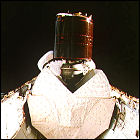 On the first fully-operational flight of NASA’s Space Transportation System, Space Shuttle Columbia delivers two commercial satellites to orbit, the Canadian Anik C-3 satellite and an American satellite, SitS-C. Aboard Columbia for this flight is the first four-astronaut crew in NASA’s history, consisting of Commander Vance Brand, Pilot Robert Overmyer, and mission specialists Joseph Allen and William Lenoir. The flight lasts five days before a landing at Edwards Air Force Base.
On the first fully-operational flight of NASA’s Space Transportation System, Space Shuttle Columbia delivers two commercial satellites to orbit, the Canadian Anik C-3 satellite and an American satellite, SitS-C. Aboard Columbia for this flight is the first four-astronaut crew in NASA’s history, consisting of Commander Vance Brand, Pilot Robert Overmyer, and mission specialists Joseph Allen and William Lenoir. The flight lasts five days before a landing at Edwards Air Force Base.
“The test flights are over”
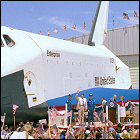 Space Shuttle Columbia lands at Edwards Air Force Base in California, making its first-ever landing on a concrete runway. After greeting the returning astronauts and inspecting the shuttle, President Ronald Reagan – with the partially-dismantled prototype Enterprise as a backdrop – declares NASA’s Space Shuttle system fully operational, saying “the test flights are over.” Columbia Commander Ken Mattingly later reveals that there was tremendous pressure on NASA to land Columbia on Independence Day, regardless of how many mission objectives had been met, to maximize the publicity value of the President’s speech. But the quick turnaround time and almost-weekly flight schedule that NASA had publicized throughout the 1970s is already a pipe dream: post-mission the four missions flown so far prove that post-landing servicing of each orbiter takes longer than expected. Columbia won’t fly again until the first “operational” mission in November.
Space Shuttle Columbia lands at Edwards Air Force Base in California, making its first-ever landing on a concrete runway. After greeting the returning astronauts and inspecting the shuttle, President Ronald Reagan – with the partially-dismantled prototype Enterprise as a backdrop – declares NASA’s Space Shuttle system fully operational, saying “the test flights are over.” Columbia Commander Ken Mattingly later reveals that there was tremendous pressure on NASA to land Columbia on Independence Day, regardless of how many mission objectives had been met, to maximize the publicity value of the President’s speech. But the quick turnaround time and almost-weekly flight schedule that NASA had publicized throughout the 1970s is already a pipe dream: post-mission the four missions flown so far prove that post-landing servicing of each orbiter takes longer than expected. Columbia won’t fly again until the first “operational” mission in November.
Challenger rollout
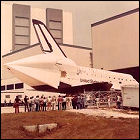 Completely refitted from a lightweight airframe originally fabricated for stress, vibration and thermal testing, Space Shuttle Challenger is rolled out of her Rockwell International assembly plant in Palmdale, California. Experience gained in the construction of Challenger’s sister ship, Columbia, means that the second completed shuttle in the fleet is over one ton lighter than Columbia. Challenger would make her first flight in just under a year.
Completely refitted from a lightweight airframe originally fabricated for stress, vibration and thermal testing, Space Shuttle Challenger is rolled out of her Rockwell International assembly plant in Palmdale, California. Experience gained in the construction of Challenger’s sister ship, Columbia, means that the second completed shuttle in the fleet is over one ton lighter than Columbia. Challenger would make her first flight in just under a year.
STS-4
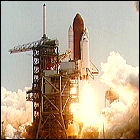 Space Shuttle Columbia lifts off for the fourth and final shuttle “test flight” before NASA’s Space Transportation System is declared fully operational. Remaining in orbit for a full week, Commander Ken Mattingly and Pilot Henry Hartsfield deliver the shuttle program’s first payload for the Department of Defense, as well as some of the first student-submitted experiment packages flown in the shuttle program. Both of Columbia’s solid rocket boosters, which are considered a reusable part of the launch vehicle, are lost at sea when their parachutes fail to deploy after separation and the boosters slam into the Atlantic Ocean; neither of the rockets are able to be recovered.
Space Shuttle Columbia lifts off for the fourth and final shuttle “test flight” before NASA’s Space Transportation System is declared fully operational. Remaining in orbit for a full week, Commander Ken Mattingly and Pilot Henry Hartsfield deliver the shuttle program’s first payload for the Department of Defense, as well as some of the first student-submitted experiment packages flown in the shuttle program. Both of Columbia’s solid rocket boosters, which are considered a reusable part of the launch vehicle, are lost at sea when their parachutes fail to deploy after separation and the boosters slam into the Atlantic Ocean; neither of the rockets are able to be recovered.
STS-3
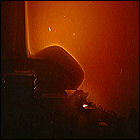 The testing phase of the shuttle program continues as Space Shuttle Columbia lifts off for her third flight into space. With Commander Jack Lousma and Pilot C. Gordon Fullerton aboard, Columbia stays in orbit for over a week, testing the orbiter’s endurance to heat at different angles to the sun, as well as testing the unmanned Spacelab experiment pallets in the cargo bay. This is the first shuttle flight to end on the contingency landing site at White Sands, New Mexico.
The testing phase of the shuttle program continues as Space Shuttle Columbia lifts off for her third flight into space. With Commander Jack Lousma and Pilot C. Gordon Fullerton aboard, Columbia stays in orbit for over a week, testing the orbiter’s endurance to heat at different angles to the sun, as well as testing the unmanned Spacelab experiment pallets in the cargo bay. This is the first shuttle flight to end on the contingency landing site at White Sands, New Mexico.
Endeavouring to keep spares on hand
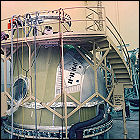 At Rockwell International, a spare Space Shuttle crew module is assembled alongside components intended for the orbiters Discovery and Atlantis, and though the spare isn’t intended for a specific shuttle yet to be built, it will find a purpose in the wake of the 1986 Challenger disaster: the spare crew module will become one of many completed shuttle spares that will eventually be assembled in the late 1980s as the Space Shuttle Endeavour, Challenger’s replacement and the last space shuttle constructed.
At Rockwell International, a spare Space Shuttle crew module is assembled alongside components intended for the orbiters Discovery and Atlantis, and though the spare isn’t intended for a specific shuttle yet to be built, it will find a purpose in the wake of the 1986 Challenger disaster: the spare crew module will become one of many completed shuttle spares that will eventually be assembled in the late 1980s as the Space Shuttle Endeavour, Challenger’s replacement and the last space shuttle constructed.
Columbia takes up arm
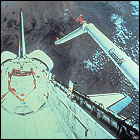 Key to NASA’s claim that the Space Shuttle will be able to deploy, retrieve and repair satellites is the Canadian-built remote manipulator arm system (or “Canadarm”), a project first contracted in 1975 and making its first appearance on Columbia‘s second flight. During tests, the arm performs exactly as expected, and proves to be absolutely vital to many future shuttle missions. The Canadian Space Agency and its subcontractors quickly receive further orders – a Canadarm for every shuttle in the fleet. Fuel cell problems shorten Columbia’s mission from five days to two days, but the crew still accomplishes most of the planned objectives and experiments.
Key to NASA’s claim that the Space Shuttle will be able to deploy, retrieve and repair satellites is the Canadian-built remote manipulator arm system (or “Canadarm”), a project first contracted in 1975 and making its first appearance on Columbia‘s second flight. During tests, the arm performs exactly as expected, and proves to be absolutely vital to many future shuttle missions. The Canadian Space Agency and its subcontractors quickly receive further orders – a Canadarm for every shuttle in the fleet. Fuel cell problems shorten Columbia’s mission from five days to two days, but the crew still accomplishes most of the planned objectives and experiments.
STS-2: Columbia rides again
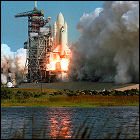 For the first time in history, a space vehicle returns to space for a second complete mission. Space Shuttle Columbia lifts off on its second test flight, with another two-man crew consisting of Joe Engle and Richard Truly, the first all-rookie American space crew since the last Skylab flight. Refinements to various systems are to be tested on this mission, as well as the first use of the remote manipulator arm, upon which nearly all claims of the shuttle’s ability to deploy, retrieve and repair satellites rest.
For the first time in history, a space vehicle returns to space for a second complete mission. Space Shuttle Columbia lifts off on its second test flight, with another two-man crew consisting of Joe Engle and Richard Truly, the first all-rookie American space crew since the last Skylab flight. Refinements to various systems are to be tested on this mission, as well as the first use of the remote manipulator arm, upon which nearly all claims of the shuttle’s ability to deploy, retrieve and repair satellites rest.
Fuel spill delays Columbia’s second launch
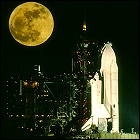 The second launch of Space Shuttle Columbia gets an unexpected one-month delay when a fuel leak forces NASA to remove, clean and re-attach 300 thermal tiles. The work can be done on-site, so Columbia simply stays on the pad. The second launch will be the last for the white external fuel tank, since NASA has determined that its brown insulating foam layer will cause no problems if left exposed; leaving off the coat of white paint saves several hundred pounds.
The second launch of Space Shuttle Columbia gets an unexpected one-month delay when a fuel leak forces NASA to remove, clean and re-attach 300 thermal tiles. The work can be done on-site, so Columbia simply stays on the pad. The second launch will be the last for the white external fuel tank, since NASA has determined that its brown insulating foam layer will cause no problems if left exposed; leaving off the coat of white paint saves several hundred pounds.
Columbia returns from orbit
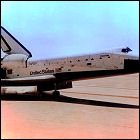 The first shuttle to return from space, Columbia touches down on the dry lake bed strip at Edwards Air Force Base in California, two days and six hours after liftoff (and after putting a cool million miles on the odometer). The aerodynamics involved in gliding after re-entry are found to be trickier than the previous test landings of the Enterprise. Inspection of the thermal tiles lining the shuttle’s belly reveals more damage than expected, and NASA begins working to refine the process of fitting the tiles to the shuttle.
The first shuttle to return from space, Columbia touches down on the dry lake bed strip at Edwards Air Force Base in California, two days and six hours after liftoff (and after putting a cool million miles on the odometer). The aerodynamics involved in gliding after re-entry are found to be trickier than the previous test landings of the Enterprise. Inspection of the thermal tiles lining the shuttle’s belly reveals more damage than expected, and NASA begins working to refine the process of fitting the tiles to the shuttle.
Columbia opens the doors
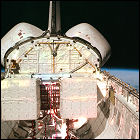 Safely in orbit, the cargo bay doors are opened for the first time on Space Shuttle Columbia, revealing that some of the shuttle’s protective thermal tiles are already missing. (A later post-landing inspection reveals that more than 100 tiles are damaged, and 16 tiles are completely lost, all probably due to unexpected vibration during launch.) NASA deems the damage non-critical and gives the go-ahead for a landing, even though it’s impossible to see what damage may have been done to the more critical tiles on the shuttle’s underbelly.
Safely in orbit, the cargo bay doors are opened for the first time on Space Shuttle Columbia, revealing that some of the shuttle’s protective thermal tiles are already missing. (A later post-landing inspection reveals that more than 100 tiles are damaged, and 16 tiles are completely lost, all probably due to unexpected vibration during launch.) NASA deems the damage non-critical and gives the go-ahead for a landing, even though it’s impossible to see what damage may have been done to the more critical tiles on the shuttle’s underbelly.
STS-1: Columbia’s first flight
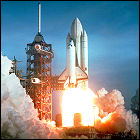 Space Shuttle Columbia lifts off on the shuttle system’s first flight into a space, with Commander John Young (a Gemini/Apollo veteran) and Robert Crippen aboard, the first two-man American crew since the Gemini program’s final flight in 1966. It’s a true test flight in every sense of the word – every previous American manned spacecraft had been flown unmanned first to verify safety and spaceworthiness, making the shuttle’s first flight a case where everything has to go perfectly the first time.
Space Shuttle Columbia lifts off on the shuttle system’s first flight into a space, with Commander John Young (a Gemini/Apollo veteran) and Robert Crippen aboard, the first two-man American crew since the Gemini program’s final flight in 1966. It’s a true test flight in every sense of the word – every previous American manned spacecraft had been flown unmanned first to verify safety and spaceworthiness, making the shuttle’s first flight a case where everything has to go perfectly the first time.
Columbia launch scrubbed
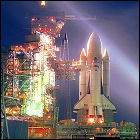 The first attempt to launch Space Shuttle Columbia on her maiden voyage is called off due to problems with the shuttle’s sophisticated system of redundant flight computers, some of which fail to synchronize with each other during the countdown. Over 24 hours are required to fix the bug, and the launch is delayed by two days.
The first attempt to launch Space Shuttle Columbia on her maiden voyage is called off due to problems with the shuttle’s sophisticated system of redundant flight computers, some of which fail to synchronize with each other during the countdown. Over 24 hours are required to fix the bug, and the launch is delayed by two days.
Columbia rolls out to the pad
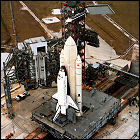 For the first time in the history of the delay-riddled Space Shuttle program, a complete, flight-ready vehicle is rolled out to the launch pad. Space Shuttle Columbia, atop the modified crawler vehicle which once carried Saturn V rockets to the pad, arrives at Cape Canaveral Launch Complex 39A, strapped to flight-qualified solid rocket boosters and a flight-ready external tank. (The shuttle Enterprise had been attached to empty boosters and tanks for fit checks as early as 1979.) Though preparation work continues to ready Columbia for flight, the shuttle is now in position for her first launch in 1981.
For the first time in the history of the delay-riddled Space Shuttle program, a complete, flight-ready vehicle is rolled out to the launch pad. Space Shuttle Columbia, atop the modified crawler vehicle which once carried Saturn V rockets to the pad, arrives at Cape Canaveral Launch Complex 39A, strapped to flight-qualified solid rocket boosters and a flight-ready external tank. (The shuttle Enterprise had been attached to empty boosters and tanks for fit checks as early as 1979.) Though preparation work continues to ready Columbia for flight, the shuttle is now in position for her first launch in 1981.
Atlantis under construction
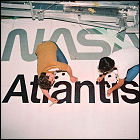 Construction begins on what is intended to be the fourth and final member of the current Space Shuttle fleet, Atlantis. With four orbiters in service, NASA will be one step closer to the routine, almost-weekly schedule of orbital flights envisioned in the Nixon-era mandate for the shuttle. Refinements and improvements in the process of constructing the shuttle fleet make Atlantis the lightest shuttle to date, over three tons lighter than Columbia.
Construction begins on what is intended to be the fourth and final member of the current Space Shuttle fleet, Atlantis. With four orbiters in service, NASA will be one step closer to the routine, almost-weekly schedule of orbital flights envisioned in the Nixon-era mandate for the shuttle. Refinements and improvements in the process of constructing the shuttle fleet make Atlantis the lightest shuttle to date, over three tons lighter than Columbia.
Discovery under construction
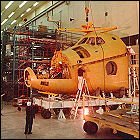 With NASA anticipating ramping up its launch schedule to more than one shuttle flight per month to meet demand for the vehicle’s unique satellite deployment and retrieval capabilities, construction begins on the third orbiter intended for spaceflight, Space Shuttle Discovery. Construction and checking of the third shuttle takes almost exactly four years, with Discovery’s first liftoff about a year later.
With NASA anticipating ramping up its launch schedule to more than one shuttle flight per month to meet demand for the vehicle’s unique satellite deployment and retrieval capabilities, construction begins on the third orbiter intended for spaceflight, Space Shuttle Discovery. Construction and checking of the third shuttle takes almost exactly four years, with Discovery’s first liftoff about a year later.
Enterprise rolls out to the pad
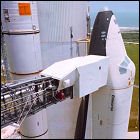 The Space Shuttle Enterprise, a full-sized, full-weight test article not intended for orbital flight, is mated to an external tank and a pair of solid rocket boosters and rolled out to Launch Complex 39A at Cape Canaveral for engineering fit-checks of the redesigned launch pad (a hand-me-down from the Apollo era, where the same pad had launched all but one of the Saturn V rockets). Enterprise remains on the pad for over a month, providing the first photo opportunity of the full-size shuttle launch stack in all of its glory.
The Space Shuttle Enterprise, a full-sized, full-weight test article not intended for orbital flight, is mated to an external tank and a pair of solid rocket boosters and rolled out to Launch Complex 39A at Cape Canaveral for engineering fit-checks of the redesigned launch pad (a hand-me-down from the Apollo era, where the same pad had launched all but one of the Saturn V rockets). Enterprise remains on the pad for over a month, providing the first photo opportunity of the full-size shuttle launch stack in all of its glory.
Columbia completed (almost)
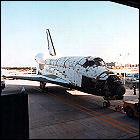 Space Shuttle Columbia is officially rolled out of the Rockwell International construction facility in Palmdale, California, even though her outer “skin” is still unfinished – NASA technicians continue working on perfecting the first spaceworthy shuttle’s thermal tiles for much of the next year, delaying the first launch until sometime in 1981 (just another in a series of delays for a vehicle that had been intended to fly as early as 1977).
Space Shuttle Columbia is officially rolled out of the Rockwell International construction facility in Palmdale, California, even though her outer “skin” is still unfinished – NASA technicians continue working on perfecting the first spaceworthy shuttle’s thermal tiles for much of the next year, delaying the first launch until sometime in 1981 (just another in a series of delays for a vehicle that had been intended to fly as early as 1977).
Christening the fleet
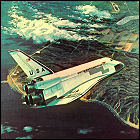 After several years of referring to the various Space Shuttle orbiters both under construction and in planning by numbers, NASA bestows names upon the anticipated fleet of four orbiters. OV-102, which is still expected to fly “late this year”, is named Columbia, while OV-099, undergoing conversion from a test article to flight-worthy vehicle, is named Challenger. Orbiters 103 and 104 will be named, respectively, Discovery and Atlantis; all four names are drawn from historical seafaring exploration vessels. (NASA has also used some of the names before: Columbia was the name of the moon-orbiting command module in the Apollo 11 mission, while Apollo 17’s lunar lander was named Challenger.)
After several years of referring to the various Space Shuttle orbiters both under construction and in planning by numbers, NASA bestows names upon the anticipated fleet of four orbiters. OV-102, which is still expected to fly “late this year”, is named Columbia, while OV-099, undergoing conversion from a test article to flight-worthy vehicle, is named Challenger. Orbiters 103 and 104 will be named, respectively, Discovery and Atlantis; all four names are drawn from historical seafaring exploration vessels. (NASA has also used some of the names before: Columbia was the name of the moon-orbiting command module in the Apollo 11 mission, while Apollo 17’s lunar lander was named Challenger.)
STA-099 to OV-099
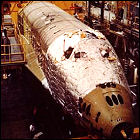 With a newly-awarded NASA contract in hand, Rockwell International begins the process of converting Space Shuttle Structural Test Article 099 into the Orbiter Vehicle 099, later to be christened Space Shuttle Challenger. A process originally envisioned for the test vehicle Enterprise, it is deemed more cost-effective and faster to upgrade STA-099 into OV-099. The first order of business is the construction of a new crew module, since the corresponding section of STA-099 was never actually intended to house human beings.
With a newly-awarded NASA contract in hand, Rockwell International begins the process of converting Space Shuttle Structural Test Article 099 into the Orbiter Vehicle 099, later to be christened Space Shuttle Challenger. A process originally envisioned for the test vehicle Enterprise, it is deemed more cost-effective and faster to upgrade STA-099 into OV-099. The first order of business is the construction of a new crew module, since the corresponding section of STA-099 was never actually intended to house human beings.
Saving Skylab?
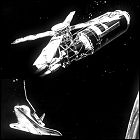 NASA and its contractors mull over a report outlining an ambitious (and, considering the continuous delays to the first launch of the Space Shuttle program, overly optimistic) plan to reactivate and occupy the Apollo-era space station Skylab for use by shuttle crews. The plan involves outfitting the ailing station with new solar power panels and equipment, and performing repairs to make it habitable for future astronauts. Despite the best-laid plans, however, the shuttle’s first launch comes after Skylab tumbles back through Earth’s atmosphere.
NASA and its contractors mull over a report outlining an ambitious (and, considering the continuous delays to the first launch of the Space Shuttle program, overly optimistic) plan to reactivate and occupy the Apollo-era space station Skylab for use by shuttle crews. The plan involves outfitting the ailing station with new solar power panels and equipment, and performing repairs to make it habitable for future astronauts. Despite the best-laid plans, however, the shuttle’s first launch comes after Skylab tumbles back through Earth’s atmosphere.
Enterprise Approach & Landing Test 5
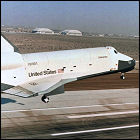 Astronauts Fred Haise and Gordon Fullerton bring Space Shuttle Enterprise back to the ground safely for its fifth free-flight landing test, the second to land with the shuttle’s engines exposed and the first to land on an actual paved runway at Edwards Air Force Base. The crew successfully compensates for a “bouncing” problem experienced on previous shuttle test landings, proving that Enterprise’s sister ships should be able to land safely after returning from orbit. Following this test, Enterprise is slated to undergo a major refit to finish it out into a spaceworthy orbiter, but NASA ultimately decides the process is too expensive. This is the final free-flight of Space Shuttle Enterprise.
Astronauts Fred Haise and Gordon Fullerton bring Space Shuttle Enterprise back to the ground safely for its fifth free-flight landing test, the second to land with the shuttle’s engines exposed and the first to land on an actual paved runway at Edwards Air Force Base. The crew successfully compensates for a “bouncing” problem experienced on previous shuttle test landings, proving that Enterprise’s sister ships should be able to land safely after returning from orbit. Following this test, Enterprise is slated to undergo a major refit to finish it out into a spaceworthy orbiter, but NASA ultimately decides the process is too expensive. This is the final free-flight of Space Shuttle Enterprise.
The Space Shuttle’s ambitious schedule
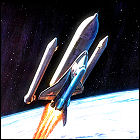 NASA prepares a preliminary schedule of Space Shuttle launches, covering the years 1979-1982 (and assuming the shuttle will be ready to launch in 1979). The ambitious schedule (which also assumes, in line with current planning, that the test orbiter Enterprise will be upgraded to spaceworthiness) includes almost-monthly flights from 1979 onward to deploy communications and weather satellites already on the drawing board, as well as frequent science missions with the cargo-bay-mounted Spacelab. On only the second test flight, the schedule has OV-102 (yet to be named Columbia) slated for a mission to the abandoned early 1970s space station Skylab, using a teleoperator retrieval system which also exists only on paper. While many of the schedule’s goals will be met, the delay in the shuttle program will be longer than NASA anticipates at this time.
NASA prepares a preliminary schedule of Space Shuttle launches, covering the years 1979-1982 (and assuming the shuttle will be ready to launch in 1979). The ambitious schedule (which also assumes, in line with current planning, that the test orbiter Enterprise will be upgraded to spaceworthiness) includes almost-monthly flights from 1979 onward to deploy communications and weather satellites already on the drawing board, as well as frequent science missions with the cargo-bay-mounted Spacelab. On only the second test flight, the schedule has OV-102 (yet to be named Columbia) slated for a mission to the abandoned early 1970s space station Skylab, using a teleoperator retrieval system which also exists only on paper. While many of the schedule’s goals will be met, the delay in the shuttle program will be longer than NASA anticipates at this time.
Enterprise Approach & Landing Test 4
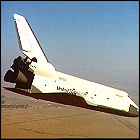 Space Shuttle Enterprise makes its fourth free-flight after separating from its modified Boeing 747 carrier aircraft, gliding to a safe landing at Edwards Air Force Base’s dry lake bed runway. For the first time, Enterprise’s engines are left exposed, adding to the drag experienced by the gliding shuttle rather than masking the engines with a protective cover. This more accurately simulates the aerodynamics of a shuttle returning from space. Enterprise’s crew for the two-and-a-half-minute flight consists of Joe Engle and Richard Truly.
Space Shuttle Enterprise makes its fourth free-flight after separating from its modified Boeing 747 carrier aircraft, gliding to a safe landing at Edwards Air Force Base’s dry lake bed runway. For the first time, Enterprise’s engines are left exposed, adding to the drag experienced by the gliding shuttle rather than masking the engines with a protective cover. This more accurately simulates the aerodynamics of a shuttle returning from space. Enterprise’s crew for the two-and-a-half-minute flight consists of Joe Engle and Richard Truly.
Enterprise Approach & Landing Test 3
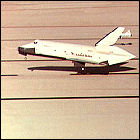 For the third time, Space Shuttle Enterprise separates from the back of a Boeing 747 flying at nearly 25,000 feet above the dry lake bed landing strips at Edwards Air Force Base in California. With astronauts Fred Haise and Gordon Fullerton aboard, Enterprise safely glides to her third safe landing at Edwards. This is the last of the test landings to leave the aerodynamic tail cone over Enterprise’s “anatomically correct” (but nonfunctional) main engines; the remaining Approach & Landing test flights will test the aerodynamics of an orbiter as it would return from space with those engines exposed.
For the third time, Space Shuttle Enterprise separates from the back of a Boeing 747 flying at nearly 25,000 feet above the dry lake bed landing strips at Edwards Air Force Base in California. With astronauts Fred Haise and Gordon Fullerton aboard, Enterprise safely glides to her third safe landing at Edwards. This is the last of the test landings to leave the aerodynamic tail cone over Enterprise’s “anatomically correct” (but nonfunctional) main engines; the remaining Approach & Landing test flights will test the aerodynamics of an orbiter as it would return from space with those engines exposed.
Enterprise Approach & Landing Test 2
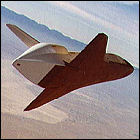 For the second time, the Space Shuttle Enterprise makes a safe landing at Edwards Air Force base after being released from the back of NASA’s 747 Shuttle Carrier Aircraft at the higher altitude of 26,000 feet over the Mojave Desert. Again testing the shuttle’s glide-only landing method, Enterprise has no engines to keep it aloft and glides to a successful landing.
For the second time, the Space Shuttle Enterprise makes a safe landing at Edwards Air Force base after being released from the back of NASA’s 747 Shuttle Carrier Aircraft at the higher altitude of 26,000 feet over the Mojave Desert. Again testing the shuttle’s glide-only landing method, Enterprise has no engines to keep it aloft and glides to a successful landing.
Space Shuttle external tank
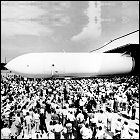 The first Space Shuttle external tank, given the designation MPTA-ET (main propulsion test article external tank), is completed at NASA’a Michoud assembly plant in New Orleans. Though constructed to flight specifications (as they stand in 1977), MPTA-ET is not intended for orbital flight, but is instead erected on a test firing stand at a NASA facility in Mississippi for tests of the three-engine shuttle propulsion system, tests which do not produce a satisfactory result until July 1980. Its job completed, MPTA-ET is later put on display at the U.S. Space & Rocket Center in Huntsville, Alabama.
The first Space Shuttle external tank, given the designation MPTA-ET (main propulsion test article external tank), is completed at NASA’a Michoud assembly plant in New Orleans. Though constructed to flight specifications (as they stand in 1977), MPTA-ET is not intended for orbital flight, but is instead erected on a test firing stand at a NASA facility in Mississippi for tests of the three-engine shuttle propulsion system, tests which do not produce a satisfactory result until July 1980. Its job completed, MPTA-ET is later put on display at the U.S. Space & Rocket Center in Huntsville, Alabama.
Enterprise Approach & Landing Test 1
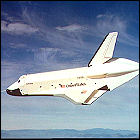 Released from its 747 Shuttle Carrier Aircraft in mid-air for the first time, and airborne on its own for the first time, the Space Shuttle Enterprise takes wing over the dry lake bed at Edwards Air Force Base for a test landing. With no engines on board (a test shuttle that will never go into orbit, Enterprise isn’t equipped with them) and only one shot at a safe landing, Enterprise successfully touches down on the runway after a flight lasting only a few minutes, validating the unpowered approach method of landing a shuttle just returned from space.
Released from its 747 Shuttle Carrier Aircraft in mid-air for the first time, and airborne on its own for the first time, the Space Shuttle Enterprise takes wing over the dry lake bed at Edwards Air Force Base for a test landing. With no engines on board (a test shuttle that will never go into orbit, Enterprise isn’t equipped with them) and only one shot at a safe landing, Enterprise successfully touches down on the runway after a flight lasting only a few minutes, validating the unpowered approach method of landing a shuttle just returned from space.
Enterprise goes around the block again
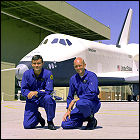 Space Shuttle Enterprise takes off – on the back of a Boeing 747 – for the last of its “active-captive” flights, with a crew aboard and all systems powered up. For this final test flight prior to the first free-flight landing test mere weeks away, Enterprise is again crewed by astronauts Fred Haise and Gordon Fullerton, and reaches an altitude of 30,000 feet.
Space Shuttle Enterprise takes off – on the back of a Boeing 747 – for the last of its “active-captive” flights, with a crew aboard and all systems powered up. For this final test flight prior to the first free-flight landing test mere weeks away, Enterprise is again crewed by astronauts Fred Haise and Gordon Fullerton, and reaches an altitude of 30,000 feet.
Enterprise takes to the sky again
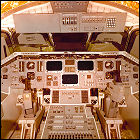 Riding the back of a modified Boeing 747, Space Shuttle Enterprise ascends to 22,000 feet for her second “active-captive” test flight, with all systems powered up and a crew aboard (astronauts Joe Engle and Richard Truly). The combined vehicle reaches speeds of over 300 miles per hour, and angles for “dropoff” – for upcoming test flights in which the Enterprise will actually separate from the 747 and glide to its landing strip – are studied for future reference.
Riding the back of a modified Boeing 747, Space Shuttle Enterprise ascends to 22,000 feet for her second “active-captive” test flight, with all systems powered up and a crew aboard (astronauts Joe Engle and Richard Truly). The combined vehicle reaches speeds of over 300 miles per hour, and angles for “dropoff” – for upcoming test flights in which the Enterprise will actually separate from the 747 and glide to its landing strip – are studied for future reference.